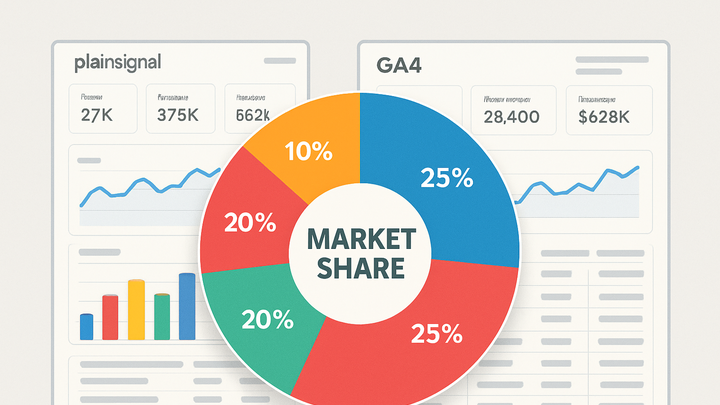Published on 2025-06-28T07:39:35Z
What is Market Share in Analytics? Examples and Insights.
Market share measures a company’s proportion of total sales or traffic within a defined market. In analytics, it refers to comparing your website’s traffic, e-commerce revenue, or user engagement against aggregate industry or competitor data. By calculating market share, businesses can understand their relative position, identify growth opportunities, and benchmark performance over time. Analytics platforms like PlainSignal or Google Analytics 4 collect the necessary data—visits, conversions, and revenue—to derive actionable market share insights. Combining internal analytics with external market data provides a comprehensive view of competitive dynamics.
Market share
Market share quantifies a company's share of total traffic or sales in its market, tracked via analytics tools.
Why Market Share Matters
Understanding market share is crucial for assessing competitive strength and growth potential. It highlights how well a business captures demand relative to competitors and guides strategic decisions in marketing, product development, and resource allocation.
-
Competitive benchmarking
Market share reveals where you stand against competitors by showing the percentage of total market volume you control. A higher market share often correlates with stronger brand recognition and pricing power.
-
Growth tracking
Tracking changes in market share over time uncovers trends indicating whether you are gaining or losing ground. This helps focus efforts on underperforming segments or regions.
-
Investor and stakeholder insight
Investors view market share as a proxy for market leadership and scalability. A growing share can boost confidence and impact funding or valuation decisions.
How Market Share is Calculated
The basic formula for market share is your key metric (e.g., sales revenue or website visits) divided by the total market metric, multiplied by 100. Accurate calculation depends on clearly defined market boundaries and reliable data sources.
-
Define the market scope
Identify the geography, industry vertical, or product category within which you measure performance. Narrow definitions yield more precise insights.
-
Collect your data
Use analytics tools like PlainSignal or GA4 to gather your website traffic and e-commerce revenue data. Ensure consistent event tracking across all channels.
-
Obtain total market data
Leverage industry reports, public datasets, or analytics benchmarking features to estimate the market total. GA4 360 users can use Google’s Benchmarking reports for this purpose.
-
Apply the formula
Calculate: (Your Metric / Total Market Metric) × 100 = Market Share. Document all assumptions and data sources for transparency.
Examples Using Analytics Tools
Here are practical examples of how to set up tracking and calculate market share with popular analytics platforms.
-
PlainSignal (cookie-free simple analytics)
To track visits with PlainSignal, add this snippet to your site’s
<head>:<link rel='preconnect' href='//eu.plainsignal.com/' crossorigin /> <script defer data-do='yourwebsitedomain.com' data-id='0GQV1xmtzQQ' data-api='//eu.plainsignal.com' src='//cdn.plainsignal.com/plainsignal-min.js'></script>Then, export your traffic data and compare it to industry benchmarks to derive your traffic market share.
-
Google analytics 4 (GA4)
Implement GA4 with the following code:
<script async src='https://www.googletagmanager.com/gtag/js?id=G-XXXXXXX'></script> <script> window.dataLayer = window.dataLayer || []; function gtag(){dataLayer.push(arguments);} gtag('js', new Date()); gtag('config', 'G-XXXXXXX'); </script>Use GA4’s Events and E-commerce reports to gather your revenue numbers, then combine them with benchmarking data for total market revenue.
Strategies to Improve Market Share
After measuring your market share, apply targeted strategies to boost it. Focus on product enhancements, pricing, promotion, and distribution to gain competitive advantage.
-
Enhance product offerings
Innovate features or services that address unmet customer needs, creating differentiation and attracting new market segments.
-
Optimize pricing
Use competitive analysis and dynamic pricing strategies to make your offerings more appealing without eroding margins.
-
Expand marketing channels
Leverage SEO, social media, and partnerships to increase brand visibility and drive qualified traffic.
-
Improve distribution
Explore additional sales channels—such as marketplaces or affiliates—to reach a wider audience.
